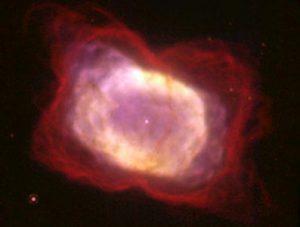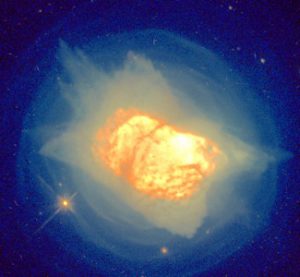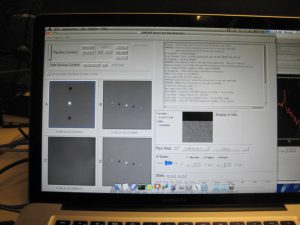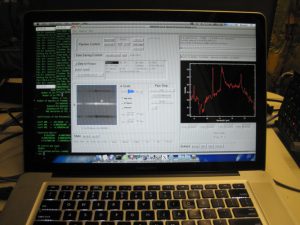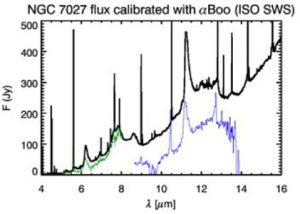Reposted from https://blogs.nasa.gov/mission-ames/2013/06/13/post_1371090905677/.
On Leg #7, between 9:45pm PDT (04:45 UTC) and 10:49pm PDT(05:49 UTC), the pilots flew SOFIA along a leg going southeast from middleMontana to northeast Colorado. Our target was NGC7027, a planetary nebula. It has a distinctive ring shape, and a frequent wavelength calibrator for infrared instruments due to having very strong emission lines.
Jim Debuizer, the USRA FORCAST Instrument Scientist, and test lead for these commissioning flights, affectionately called it the “the big glazed donut in the sky.” Perhaps he was getting a big peckish?
NGC7027 is a young, and rather dense planetary nebula. It’s not particularly large on the sky, with its brightest region measuring about ~8 arcseconds across in the optical. It’s located about 3000 light years away in the constellation Cygnus (coordinates 21h7m1.7s RA, +42d14m11s Dec). Most planetary nebulae are more extended, covering several arcminutes on the sky. (As a calibrator note, for those who don’t speak arcseconds: the full moon is 30 arcminutes or ½ degree on the sky; 1 arcsec is 1/60th of an arminute.) SOFIA’s FORCAST mid-IR instrument has roughly a platescale of0.75 arcsec/pixel. Thus, NGC7027 would appear to be ~11 pixels in diameter on the FORCAST detector. For our grism spectroscopy, we are testing 2.4 arcsec(3.2 pixel) and 4.7 arcsec (6.2 pixel) wide slits, so NGC7027 would essentially“fill our slit.” Thus it would not be a great flux calibrator object as we’d have “slit losses” but it’s infrared spectrum has well-identified and well-spaced emission features that would be useful for our wavelength calibration task.
NGC7027observed by the Hubble Space Telescope: Near-Infrared NICMOS image. (Source: http://apod.nasa.gov/apod/ap980325.html)
NGC7027observed by the Hubble Space Telescope: Composite visible & near-IR image. (Source: http://hubblesite.org/newscenter/archive/releases/1996/05/image/a/)
Images showing data reduction of an image of NGC7027 aboard SOFIA Flight#105.
Above is an image of our quicklook pipeline as I was processing an acquisition narrowband image (at 11.1um) on SOFIA Flight#105. We used this image to confirm we placed the target in the slit. The team was also testing out SLITSCAN, an observational mode that would be used on SOFIA when observing an extended object using the grism suite. The positive and negative images are the result of the chop-nod observing technique used to remove the background.
For more information about chopping & nodding on SOFIA, see my earlier post.
Image showing data reduction of an IR spectra of NGC7027 aboard SOFIA Flight#105.
Above is an image of our quicklook pipeline as I was processing our R~300 8-14 micron spectra (not fully-calibrated). We still need to remove the atmosphere. The strongest atmosphere issue are ozone absorptions at~9.5 microns. The emission features of the nebula are shown in our spectra. If you look closely at the 2D spectra on the left, you can see we aligned the slit to capture two edges of the disk, showing as two bright lines on the edges of the slit.
We were observing this object with our grism spectra suite. We took data on this same object last week and started to use it as a sanity check on our in-progress flux calibration in addition to a wavelength calibration. Below is an overlay of two of our grisms (5-8 um and 8-14 um) with the spectra ofNGC7027 as observed by ISO years ago. We now have spectra to cover 17-28 um and28-34 um, and are working on their respective calibration steps. We are using another well-studied source, Arcturus (AlphaBoo) as our flux calibrator. The reason why the 8-14 um spectra in the image below is off is because the data set we took was near-saturation so our various conversions were not optimal. We repeated the observations at lower exposure to repeat the exercise.
Our working comparison of our short wavelength grism suite data of NGC7027 with previously published observations by the Infrared Space Observatory.
It was unfortunate that during this leg (Leg #7) that we hit turbulence and had to stop observing for a few minutes. We got slitscan(observational technique for extended objects) observation in (the goal of the leg), but sadly did not a requested long wavelength grism spectra of this object. However, we obtained other spectra on other objects using the missed-grisms later in the evening. It’s all going to be able piecing together the puzzle now.

